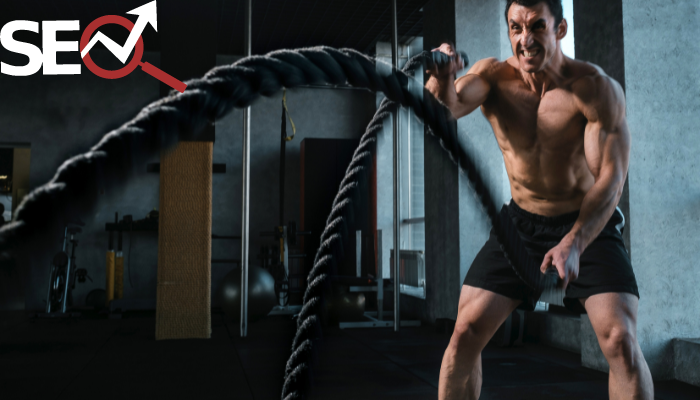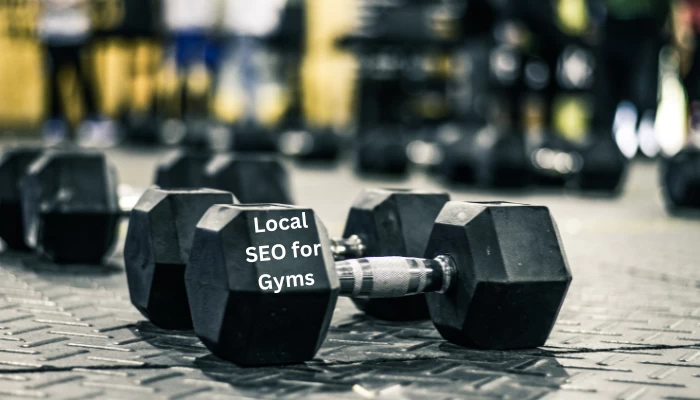Local SEO Services Near Me | Local Pro1 Welcome to...
Dominating the Digital Fitness Space: SEO for Gyms
Dominating the Digital Fitness Space| SEO for Gyms
In the highly competitive fitness industry, the importance of SEO (Search Engine Optimization) for gyms cannot be overstated. SEO serves as the digital lifeline that connects fitness enthusiasts with their ideal workout destinations. As potential gym-goers increasingly turn to search engines like Google to find the perfect fitness facility or professional, ensuring that your gym’s online presence is optimized becomes imperative. By embracing effective SEO strategies, gyms can reap a multitude of benefits, ranging from heightened online visibility and credibility to a steady stream of targeted traffic and, ultimately, increased membership sign-ups. LocalPro1 will provide you the best services of SEO for gyms.

Why is Gym SEO Beneficial for Your Business?
Increased Online Visibility: Gym SEO helps your fitness center appear higher in search engine results when potential customers look for fitness-related services in your area. This increased visibility can lead to more website traffic and, ultimately, more foot traffic to your gym.
Targeted Traffic: SEO allows you to target specific keywords and phrases related to your gym services. This ensures that the people who find your website through search engines are more likely to be interested in what you offer, increasing the chances of converting them into customers.
Builds Credibility and Trust: Websites that appear at the top of search results are often perceived as more credible and trustworthy. By optimizing your gym’s online presence, you can establish authority in your niche and build trust with potential customers.
Competitive Advantage: If your competitors are investing in SEO and you are not, they are likely to attract more online attention. By optimizing your website for search engines, you can stay competitive and even surpass other local fitness centers in online visibility.
Cost-Effective Marketing: Compared to traditional advertising methods, SEO is a cost-effective marketing strategy. Once your website is optimized and ranks well, you can attract organic traffic without continuously paying for advertising space.
Local Search Optimization: Many people search for gyms or fitness classes near their location. Local SEO strategies ensure that your gym appears prominently in local search results, making it easy for potential customers in your area to find and visit your facility.
Improved User Experience: SEO involves optimizing your website structure and content, which can improve the overall user experience. A well-organized and user-friendly website is more likely to keep visitors engaged and encourage them to explore your gym offerings.
Adaptation to Changing Consumer Behavior: With the increasing reliance on online searches to find local businesses, having a strong online presence through SEO is essential. It aligns your business with changing consumer behaviors and ensures you are visible to those who prefer to search for fitness options online.
SEO Tip for Gyms: Find Relevant Keywords
SEO (Search Engine Optimization) is crucial for gyms to increase their online visibility and attract potential customers. Here are some tips specific to gyms to improve their SEO strategy:
Understanding Keyword Research:
Understand Your Audience: Identify your target audience. Are you catering to beginners, fitness enthusiasts, or a niche market? Knowing your audience helps you tailor your keywords to their needs.
Use Keyword Research Tools: Utilize keyword research tools like Google Keyword Planner, SEMrush, or Ahrefs to discover relevant keywords related to fitness, workouts, and your specific services.
Long-Tail Keywords: Incorporate long-tail keywords that reflect specific services or offerings at your gym. Long-tail keywords often have less competition and can attract more targeted traffic.
Local SEO Keywords: Include location-specific keywords, especially if your gym operates in a specific city or region. This helps attract local customers searching for fitness services in their area.
Competitor Analysis: Analyze the keywords your competitors are using. This can provide insights into effective keywords within your niche and help you identify any gaps you can capitalize on.
Focus on User Intent: Consider the intent behind the keywords. Are users looking for fitness classes, personal trainers, or gym equipment? Tailor your keywords to match the intent of potential customers.
Update Content Regularly: Keep your website content fresh with regular updates. Search engines prefer active and relevant sites, and regularly updating your content can improve your site’s ranking.
Optimize Meta Tags and Descriptions: Ensure that your meta tags and meta descriptions contain relevant keywords. These elements are displayed in search engine results and can impact click-through rates.
Create Quality Content: Develop high-quality, informative content that naturally incorporates your chosen keywords. This not only improves SEO but also enhances the user experience.
Mobile Optimization: Optimize your website for mobile devices. Many users search for fitness-related information on their smartphones, so a mobile-friendly site can improve your SEO ranking.

Affordable SEO for Gyms
The Cost-Effective Approach to SEO:
Affordable SEO (Search Engine Optimization) for gyms is crucial to enhance online visibility, attract potential clients, and boost your gym’s digital presence. Here are some cost-effective SEO strategies tailored for gyms.
Keyword Research:
- Identify relevant keywords related to fitness, gym services, and location.
- Use tools like Google Keyword Planner or Ubersuggest to find keywords with moderate competition.
Optimize Website Content:
- Ensure your website content is user-friendly and includes relevant keywords naturally.
- Create high-quality, informative content around fitness tips, workout routines, and health advice to engage visitors.
Local SEO:
- Optimize your Google My Business profile with accurate information, including gym hours, location, and contact details.
- Encourage satisfied customers to leave positive reviews on your Google My Business page.
Mobile Optimization:
- Ensure your website is mobile-friendly as many users search for gyms on their mobile devices.
- Google gives preference to mobile-friendly websites in search rankings.
Social Media Presence:
- Maintain an active presence on social media platforms, sharing workout tips, success stories, and promotions.
- Social signals positively impact SEO, so engage with your audience on platforms like Facebook, Instagram, and Twitter.
Local Citations:
- List your gym on local directories and community websites.
- Consistent NAP (Name, Address, Phone Number) information across platforms is crucial for local SEO.
Content Marketing:
- Develop a blog on your website and regularly publish informative content writing related to fitness, health, and wellness.
- Guest posting on local blogs or collaborating with local influencers can also boost your gym’s visibility.
Link Building:
- Build high-quality backlinks by collaborating with local businesses, participating in community events, or sponsoring local sports teams.
- Avoid spammy link-building practices, as they can harm your website’s reputation.
Website Speed Optimization:
- Ensure your website loads quickly as page speed is a ranking factor for search engines.
- Compress images, use browser caching, and minimize unnecessary code to improve loading times.
Analytics and Monitoring:
- Use tools like Google Analytics to track website performance.
- Monitor keyword rankings, traffic sources, and user behavior to refine your SEO strategy over time.
Local SEO for Gyms

Local SEO (Search Engine Optimization) for gyms is crucial for attracting and retaining local customers who are actively searching for fitness services in their area. Here’s a breakdown of the importance of local SEO and steps to improve it:
Google My Business (GMB) Optimization:
- Claim and verify your Google My Business listing.
- Ensure accurate and up-to-date information, including business hours, location, contact details, and website.
- Add high-quality photos showcasing your gym facilities.
Keyword Optimization:
- Research and use relevant local keywords in your website content, meta tags, and headings.
- Include location-specific terms, such as city names or neighborhoods, in your content.
Local Content Creation:
- Develop content that is relevant to your local audience. This can include blog posts, articles, or videos about fitness trends in the area, local events, or success stories of your gym members.
- Use locally focused keywords in your content.
Online Reviews:
- Encourage satisfied customers to leave positive reviews on platforms like Google, Yelp, and other relevant review sites.
- Respond to all reviews, both positive and negative, in a professional and timely manner.
Local Citations:
- Ensure that your gym’s name, address, and phone number (NAP) are consistent across all online platforms, directories, and social media profiles.
- Get listed on local business directories and relevant industry directories.
Local Link Building:
- Build relationships with local businesses, fitness influencers, and community organizations to gain local backlinks.
- Sponsor or participate in local events and ask for event organizers to link to your website.
Mobile Optimization:
- Optimize your website for mobile devices, as many people search for local businesses on their smartphones.
- Ensure fast loading times and a user-friendly mobile experience.
Social Media Engagement:
- Maintain an active presence on social media platforms with content related to fitness, health tips, and gym updates.
- Engage with your local community by responding to comments and messages.
Local SEO Audits:
- Regularly audit your website’s local SEO performance using tools like Google Analytics, Google Search Console, and other SEO audit tools.
- Identify and fix any issues that may impact your local search ranking.
Local Ad Campaigns:
- Consider running local online advertising campaigns targeting specific demographics in your area.
- Utilize geotargeting features to reach potential customers near your gym.
Conclusion
Implementing a robust SEO strategy for gyms is paramount in today’s digital landscape to enhance online visibility, attract potential clients, and stay competitive within the fitness industry. By optimizing website content, utilizing relevant keywords, and focusing on local SEO tactics, gyms can improve their search engine rankings and draw in a targeted audience. Feel free to contact us for any type of query or services related to the SEO for gyms.
FAQs
What Is Seo, And Why Is It Important For Gyms?
SEO stands for Search Engine Optimization. It is crucial for gyms as it helps improve their online visibility, making it easier for potential clients to find them on search engines like Google. By optimizing your gym’s website, you can attract more organic traffic and increase the chances of acquiring new members.
How Can Seo Benefit My Gym’s Website?
SEO can benefit your gym’s website by enhancing its ranking on search engine results pages (SERPs). This increased visibility can drive more qualified leads to your site, potentially converting them into new gym members. It also helps build credibility and trust among your target audience.
What Are The Key Elements Of On-Page Seo For Gyms?
On-page SEO for gyms involves optimizing elements on your website, such as meta titles, meta descriptions, header tags, and content. It’s essential to incorporate relevant keywords related to fitness, location, and services. Additionally, optimizing images, improving page load speed, and ensuring mobile responsiveness contribute to a better on-page SEO.
How Can Off-Page SEO Strategies Benefit My Gym’s Online Presence?
Off-page SEO focuses on building your gym’s authority and reputation across the internet. This includes strategies like acquiring backlinks from reputable fitness websites, managing online reviews, and maintaining an active presence on social media. These efforts contribute to a positive perception of your gym in the eyes of search engines and potential customers.
How Often Should I Update My Gym’s Website Content For Optimal Seo Performance?
Regularly updating your gym’s website content is beneficial for SEO. Aim for fresh and relevant content updates, such as blog posts, class schedules, and promotional offers. Consistent updates signal to search engines that your site is active and valuable to users, potentially improving your search rankings.
Our Services
Our Latest Posts
PPC White Label Services by Local Pro1 | Expert Solutions
PPC White Label Services by Local Pro1 | Expert Solutions...



